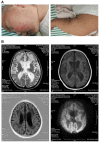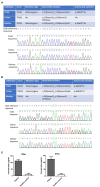Case Report: Aicardi-Goutières Syndrome Caused by Novel TREX1 Variants
- PMID: 33996686
- PMCID: PMC8113616
- DOI: 10.3389/fped.2021.634281
Case Report: Aicardi-Goutières Syndrome Caused by Novel TREX1 Variants
Abstract
TREX1 (three prime repair exonuclease 1) gene encodes DNA 3' end repair exonuclease that plays an important role in DNA repair. Mutations in TREX1 gene have been identified as the cause of a rare autoimmune neurological disease, Aicardi-Goutières syndrome (AGS). Here, we report an AGS case of a 6-month-old Chinese girl with novel TREX1 variants. The patient had mild rashes on the face and legs, increased muscle tensions in the limbs, and positive cervical correction reflex. Cranial magnetic resonance imaging showed that there were patches of slightly longer T1 and T2 signals in the bilateral cerebral hemisphere and brainstem white matter, mainly in the frontotemporal lobe, together with decreased white matter volume, enlarged ventricles, and widened sulcus fissure. Total exon sequencing showed that the TREX1 gene of the child had mutations of c.137_138insC and c.292_293insA, which had not been reported before. In addition, elevated type I interferons were detected by using enzyme-linked immunosorbent assay in the patient's serum. Together, our study demonstrated that novel TREX1 variants (c.137_138insC and c.292_293insA) cause AGS for the first time.
Keywords: Aicardi-Goutières syndrome; Trex1; case report; mutations; type I interferons.
Copyright © 2021 Wu, Fang, Huang and Ying.
Conflict of interest statement
The authors declare that the research was conducted in the absence of any commercial or financial relationships that could be construed as a potential conflict of interest.
Figures


References
Publication types
LinkOut - more resources
Full Text Sources
Other Literature Sources

